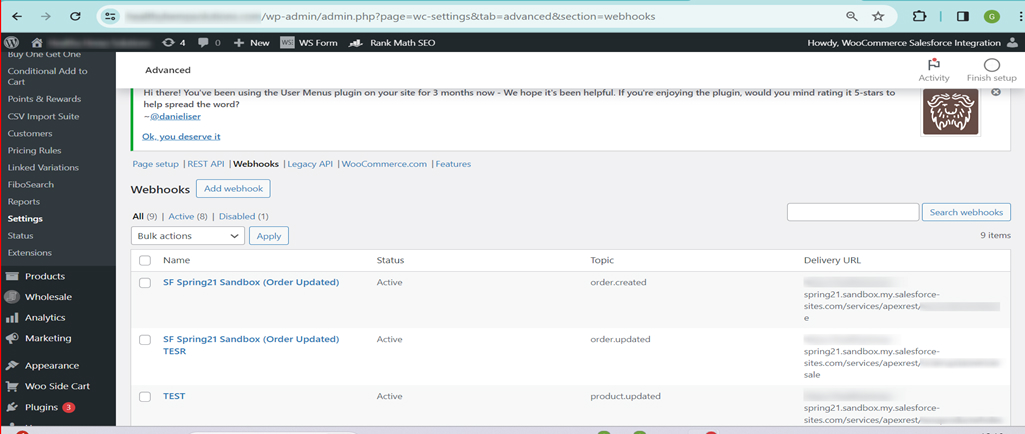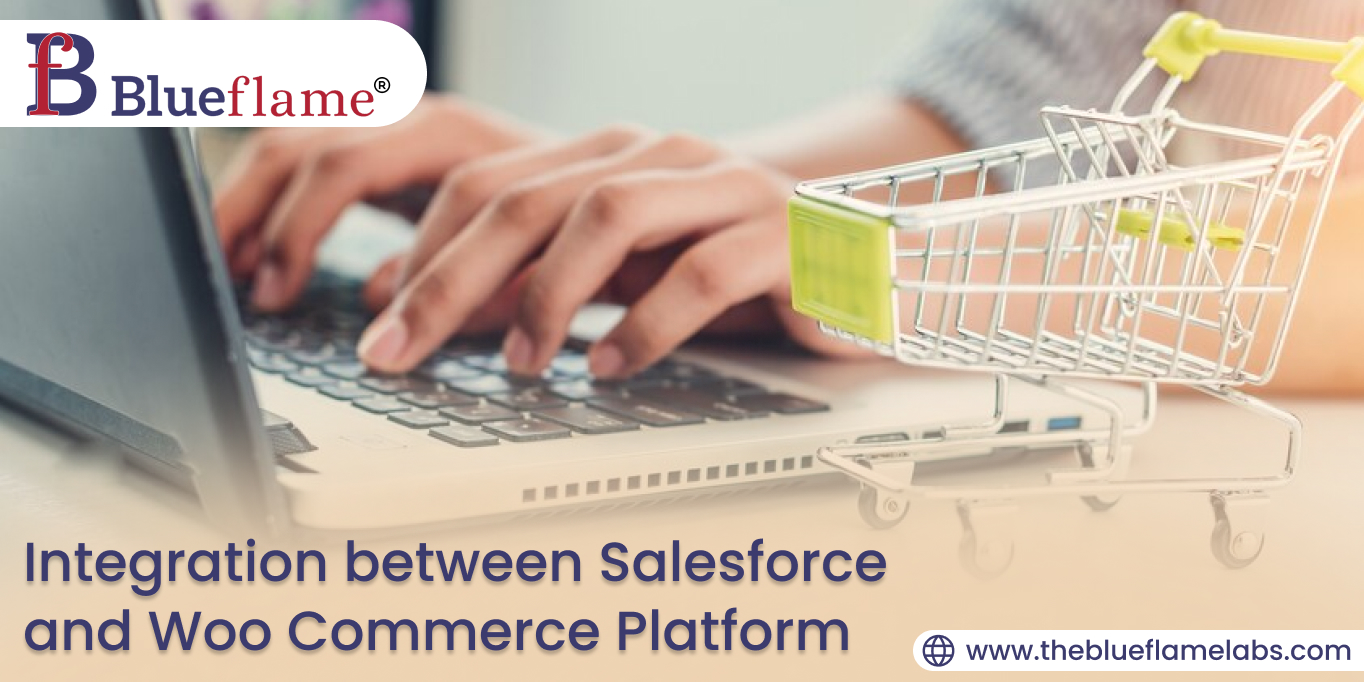Integration between Salesforce and Woo Commerce Platform
Integrating Salesforce with your WooCommerce store can transform how you manage your business. By syncing important data like products, customer contacts, and orders, you can improve efficiency and gain valuable insights. In this blog, look into how to use Apex programming and WooCommerce REST APIs to create a smooth connection between these two powerful platforms.
There are different ways through which you can integrate Salesforce with Woo commerce platform as below:
1. Third Party Integration platform
There are several third-party platforms that provide integration using Zapier, Integromat, and Workato. These platforms allow you to create automated workflows between two systems and integrate with other tools and systems.
Limitations: Third party applications work on a licensing basis and have limitations in mapping custom fields.
2. App Exchange Applications
Use this app to sync your Shopify store data, such as orders, customers, and products, with Salesforce.
Limitation: It has limited functionality for selective E-commerce object mapping.
3. REST APIs and Apex Programming
If you have technical expertise, you can use the ECommerce APIs and Salesforce's Apex programming language to create custom integrations between the two platforms. Integrating using Apex gives you full control over the integration and allows you to customize it to your specific needs. REST API integration is more focused and simpler around sending data from woo commerce and fetching data from Salesforce. Salesforce users on their enterprise plan can access the Salesforce REST integration services as there is no cost associated.
WooCommerce
Woo Commerce is a flexible software solution built for WordPress websites and it is open source. Mostly woo Commerce is used to create online e-commerce shops. If anyone wants to turn their regular website into a software solution based online store with all the e-commerce necessary features.
WooCommerce REST API is a set of powerful web APIs; Think of them as your store's operation. With REST API, you can create new and different products, update existing product IDs, manage orders and store customer information with just a few lines of code. If you already know WordPress, you will find the WooCommerce REST API very familiar. WordPress is built on REST API and follows the same standards and rules.
Here are some key features of the WooCommerce REST API:
It uses the HTTP protocol, provides a communication protocol between machines. Standard HTTP methods (such as GET, POST, PUT, DELETE, etc.) are instructions of the language, and each method operates specifically on the resources of the online store.
Versatile and highly customizable. Whatever programming language or framework you prefer, the API works well with them. This extensive compatibility allows developers to integrate their applications or systems with WooCommerce stores.
It can also be used to create custom front-end interfaces such as a storefront or your backend and backend operations. The API organizes the individual elements of the WooCommerce store into a harmonious symphony. WooCommerce REST API is more than a tool, WooCommerce is your passport to unparalleled possibilities, allowing you to customize your store to your unique needs and vision. Woo commerce REST API documentation link.
Part 1: Salesforce to WooCommerce Integration
The Latest API version of Woo Commerce is 9.0. You can access the API over either http or https.
Parameters in Request: Almost all endpoints accept parameters to be used as a HTTP query string to filter the result, e.g. GET /orders?Status=completed
Body requests use plain JSON to set or update objects. When a request is successful, a 200 OK HTTP event is returned.
Pagination: By default, single request sends 10 items. Alternatively, you can fetch more than 10 items by changing the ‘?Per_page’ parameter. E.g. GET /orders?per_page=15
- You can fetch further pages with ‘?page’ parameter- GET /orders?page=2
- You may also fetch the offset from the resource using ‘?offset’ parameter - GET /orders?offset=5
- The total number of resources and pages are included in the X-WP-Total and X-WP-TotalPages HTTP headers.
General Request details:
Date returned in ISO8601 format: YYYY-MM-DDTHH:MM:SS
The resource ID is returned as a number.
Any numeric value, such as value or total, is returned as a string with two decimal places. Cash refunds will be given for other expenses (such Chinese goods). Empty fields usually contain blanks or empty strings rather than being skipped.
Authentication to access the Woo Commerce API
You can access the Woo Commerce REST APIs using the Access key. Pre-generated keys are used authentic the REST API endpoints. Keys can be generated either through the WordPress admin interface or through key generation endpoint they can be auto generated.
Steps to generate Key are as below:
1. Go to: WooCommerce > Settings > Advanced > REST API. or
Keys and App will be found at WooCommerce > Settings > API > Key/Apps
2. You will either need to add a key or use the existing created Key.
Procedure to Add new Key:
1. Select the User you would like to generate a key from the drop down.
2. Select a level of access for this API key as Read access, write access or Read/Write access. 
3. Select Generate API Key, and WooCommerce creates API keys for that user.
Once the keys are get generated, we should be able to see Consumer Key and Consumer Secret keys, a QR Code, and a Revoke API Key button.
Code snippet to use the API Key and credentials to send data via API

Four possible types of errors you might encounter while accessing the APIs.
|
Error Code |
Details |
|
400 Bad Request |
Invalid request |
|
401 Unauthorized |
Permission/Authentication Error |
|
404 Not Found |
Request/Resources that does not exist |
|
500 Server Error |
Server Error |
Part 2 Woo Commerce to Salesforce
It is feasible to apply webhooks with WooCommerce actions, e.g., Create a webhook for use each time a product is brought to the shopping cart, using the movement woocommerce_add_to_cart. Webhooks also make it simpler for other applications to combine with WooCommerce.
Settings > Webhooks > superior > add/ search Webhook
The default name is automatically generated as "Webhook created on [date and time of creation]" to streamline the creation process. Feel free to customize the name to better suit your needs.
- Status: Set to lively (grants payload), Paused (does not deliver), or Disabled (does no longer supply due to delivery screw ups).
- Topic: imply when the webhook must be brought on – Order Created, Product Deleted, or client updated. There also are movement and Custom options.
- Event: This option is accessible when the subject pertains to a WooCommerce action, such as `woocommerce_add_to_cart`, which occurs when customers add products to their shopping cart.
- Custom topic: this selection is for superior customers only. It’s viable to introduce new, customized subjects with the assist of woocommerce_webhook_topic_hooks filter.
- Delivery URL: The URL where the webhook payload is sent.
- Secret Key name: The name of the Key generates a hash of the brought webhook and is furnished in the request headers. By default, this is set to the modern API user’s secret key if no other value is provided.
- Save Webhook.

Why to Integrate Salesforce with E-commerce Platform using Apex
Data Management
The biggest benefit of the Salesforce integration is that you can manage data across both platforms at the same time. This allows you to analyze, track, and manage your e-commerce and CRM data in a single integrated solution. This integration lets you sync key data points like orders, collections, payments, and customers between Shopify and Salesforce, so your team can deliver a unified experience to your prospects and customers.
Convert customers into contacts
Another great benefit of the Salesforce integration is the ability to convert customers into Salesforce contacts. Once a customer makes a purchase in the store, their data is recorded in the CRM database in real time.
This prevents you from manually transferring customer data from e-commerce platforms to Salesforce for further maintenance. Once you have your customers as contacts, you can analyze them and provide personalized service through integrated solutions.
Manage multiple storefronts
Salesforce's complete CRM functionality helps you manage multiple Shopify stores on Salesforce. This eliminates the need to switch between different branches to manage them.
This integration provides a comprehensive view of all branches on a single platform, making it easier for teams to support branches individually.
With the ability to manage multiple branches, you can also track customer journeys and experiences across all branches without having to switch between different platforms.
Valuable data analysis
Salesforce is known for intelligent data analysis. Integration with Salesforce Shopify allows you to analyze customer purchases from your online store.
This integration also helps you analyze search queries performed by prospects and customers to personalize your services to their preferences.
Integrating Salesforce with WooCommerce enhances efficiency and provides valuable insights by syncing orders and customer data. Whether using third-party tools or custom APIs, each method offers unique benefits. Embrace this integration to streamline operations and improve customer experiences, driving growth for your e-commerce business.
Leverage the expertise of Blueflame Labs to seamlessly integrate Salesforce with WooCommerce. This integration optimizes operations by synchronizing orders and customer data, providing actionable insights to drive business growth.
Recent Blogs

Understanding Microservices in .NET Core
Read More
Cloud-Based ERP vs. On-Premises: Why Rootstock ERP Is the Future
Read More
NetSuite Fixed Asset Management: A Step-by-Step Guide
Read More
Personalized Experiences in Salesforce D2C Commerce vs. B2B Commerce
Read More
Overcome Manual Testing Challenges using Automation Testing Tool Provar
Read More
.NET MAUI: The Future of Cross-Platform Development
Read More
Salesforce and Shopify Integration
Read More
Unlocking the Power of Rootstock Cloud ERP for Wholesale Distributors
Read More


 Strictly Necessary Cookies
Strictly Necessary Cookies